Lessons Learned from Updating the Activity UI
With the successful launch of an updated UI and interaction model for Weight Watchers Activity program, the team and I had learned some important lessons about our members and how they viewed and interacted with being active in their daily lives. Some of the key points we now knew were:
Comprehension Improved
Easier to read
Faster recall of information
FitPoints and Steps are what matters most
Felt like a metrics “meant something”
Fun to use and tap the “bubbles”
Tracking not improved
FitPoints are still confusing
Steps numbers use only to compare to Fitbit
Minutes not important
“Why track” or “Why be active” not addressed
Activity just feels good
The Plan
With the WW diet season going into full swing, I and my team had the opportunity to focus on exploration and discovery of how to address the key weakness of the Activity Program with tracking. The plan to move forward was to first enhance our understanding of current members with UX research having a particular and refined focus on Activity specifically. From a series of user interviews, we could then gather insights to form opinions on where there are “Opportunities” and “How Might We” statements geared toward updating our program to have impact on tracking behavior. With buy in from leadership we could then start to create concepts and prototypes with learnings and user testing to learn our way to a pilot study
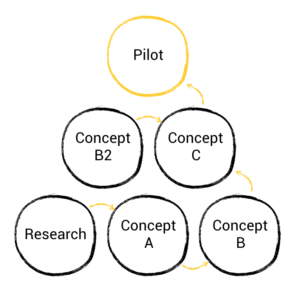
Research
With the help of WW’s UX Research team, we were able to take the opportunity to focus more in-depth on our user persona’s and flush out more about our understanding with their relationship with activity and fitness. Through 20+ interviews our persona’s were enhanced, and even modified as we learned more about the behavioral tendencies our members have. Through this research we were able to find out behaviors that our main persona exhibited, such as she does not initiate activity or events with friends outside of her family, though loves to be invited. And for our secondary persona, Vanessa was okay being uncomfortable and trying something new because she is confident that I will not regret it in the end. She also believed that a good workout is an hour long – you have to do it long enough to sweat and really push yourself.
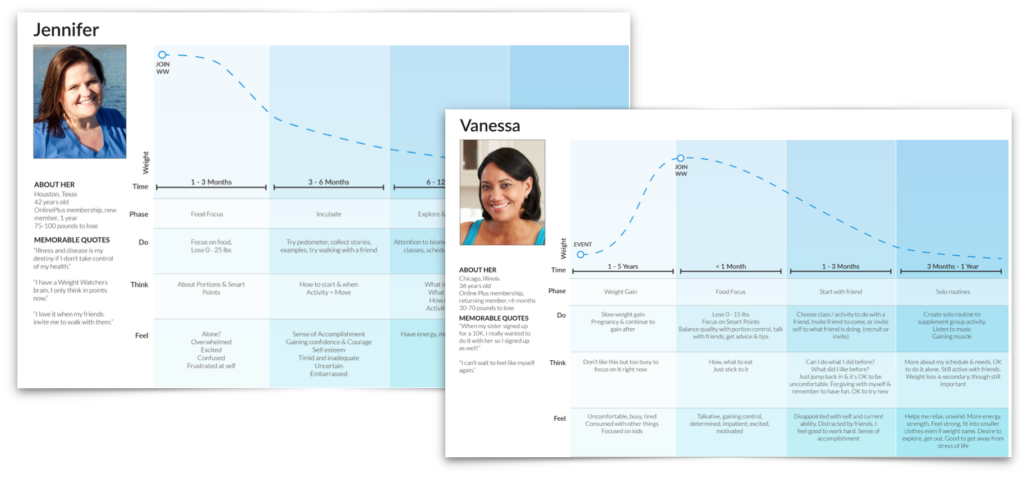
The interviews and updated personas also led the team to identify key opportunities to explore in designing new concepts that landed in two category types.
Start activity
- Food first, then activity
- Store up stories
- Start with a friend Start “small”
- Steps are a flexible target
Stay active
- Get in a routine
- Commit to a person
- Activity is a feeling
- Shape up
Member Journey
After learning more about our members, I took to the task of better understanding of how we could best cater to their differing needs to being introduced to and acknowledged for their activity accomplishments. Using Jack Knapps method from the Design Sprint, I mapped the customer journey by starting at the end, and identifying the key players, moments, and opportunities for a member who has embraced activity into their lives and knows that by doing activity, they feel good just for the sake of doing it. 
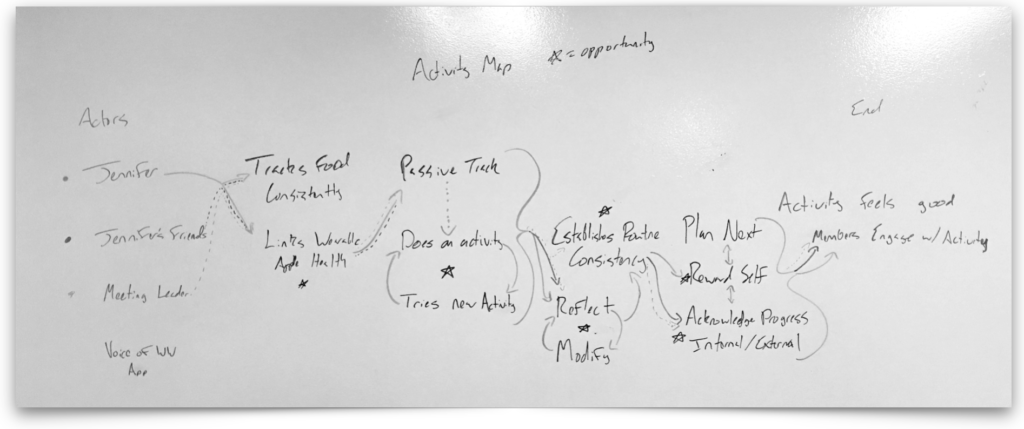
This further broke down into a system of 4 parts.
1. Identifying Intrinsic Goals – Identifying what I want to feel or be (less tired, have more energy, stronger everyday. 2. Establishing a Vision – Success would be going for at least a 10 minute walk, 3 times a week.
3. See Impact – Walking 10 minutes used to be a challenge to do once, now I can walk everyday!
4. Plan and Reflect – If I can walk for 20 minutes everyday, maybe I can try do walk a 5K, maybe try jogging!
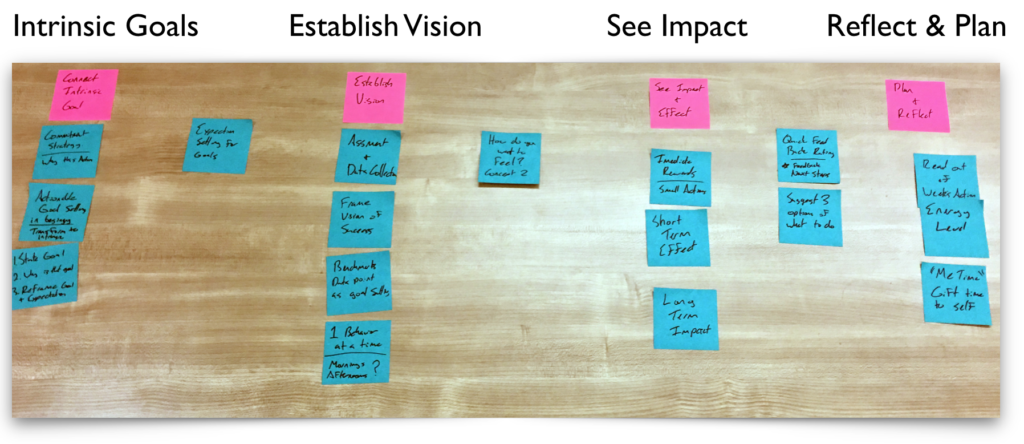
Sketch and Prototype
With the member journey understood, I set out to brainstorm and sketch a variety of concepts. Brainstorming with my team, we came up with a multitude of ideas and concepts, that further embraced the opportunities and learnings we had about Jennifer and her journey with activity.

I then collected, and refined these ideas into 4 core concepts of how to inspire and motivate jennifer to participate in actives by making them easier to do, readily available, and inviting her to join with her peers. Iterating and iterating, I was able to narrow in on some key specifics to a new program that was starting to take shape, embracing some of the core opportunities we identified earlier of “Starting small”, “Collecting stories or ideas”, and “Activity is a feeling”.
Refine and Test
The concept shaped up to be a system where, instead of building on points and a currency, we wanted to encourage and reward the act of simply being active. Setting small goals of being active 3 times a week, members could ease into the trying small, bite sized activities to learn what worked for them, and more importantly, what they liked and felt they could do. To help them discover these, we provided 5 unique activity ideas everyday, so that they could always find inspiration to try something that only took 10 minutes of their time. To also help guide them into finding actives that made them feel good, each activity idea also had an association with an type of energy or emotional response. Walking can make you feelcalm,dancing to some 80’s music will give youenergy, and chair dips will make youstrong.

Pilot
We tested our concept with a number of participants and had great responses to the ideas, making the goals clear, and people were surprisingly open to not having the hard metrics of steps or FitPoints. Signs pointed to a winning concept that we needed to test in the field, and for a longer period of time to learn true engagement with the new program. We decided to build a pilot group of 10,000 individual across the US, and around 5,000 in Australia, to keep english as the baseline language and to avoid the overhead of translating over 50 different activity ideas. It ran for 8 weeks, and after it concluded we recruited 20 participants to interview to validate our quantitative and qualitative data.
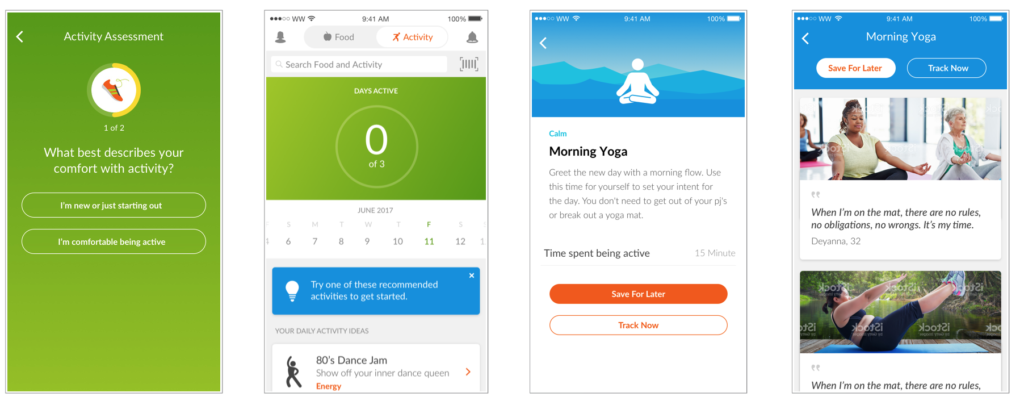
Learnings
New design had an increase in engagement
Dashboard was easy to understand and achievable
Activity ideas were fun and got people moving in unexpected ways
Not directly tying to FitPoints or Steps was questioned at first, but quickly forgotten
Ideas were more impactful for Jennifer, but Vanessa tended to self select into the program
Exercises were too easy for Vanessa, or not enough “sweat”
They would come back a few times a week to see the new exercises, potential to start building habits
Next Steps
The learnings suggested that we still had a few improvements to make, but the program itself was directionally feasible and could turn into a bigger part of the over all WW program. As the program wrapped up, WW got a new CEO, shortly after a new CPO, and is about to go through a major rebranding overhaul. It was determined that while these changes took time to settle and our new brand took shape, we would pause on Activity and resume after the winter diet season, WW’s busiest time of the year. Iterations and new ideas will be begin in the spring of 2018.